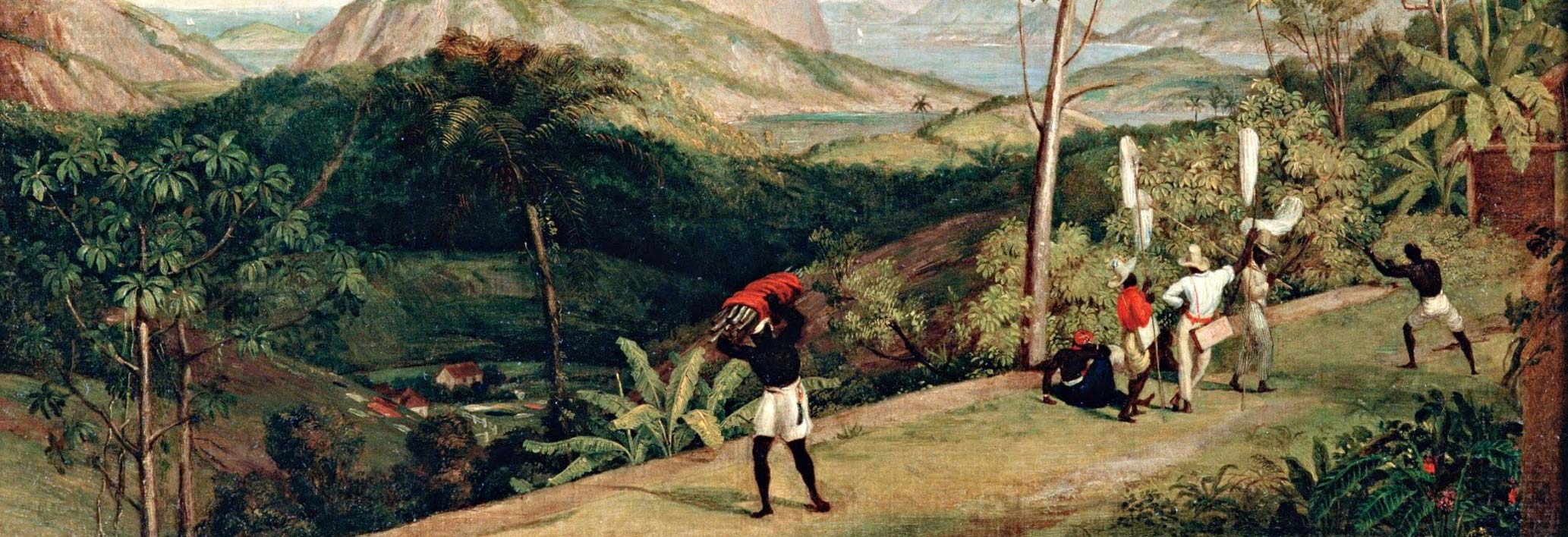Francisca da Silva de Oliveira (known as Chica da Silva), was born enslaved and raised in Tejuco (today's Diamantina), in the captaincy of Minas Gerais, Brazil. Chica obtained manumission and social prominence, becoming an icon of Brazilian mulatto power and Brazil’s so-called racial democracy.
Chica was born between 1731 and 1735 in a small village near Tejuco. She was the illegitimate daughter of the African slave Maria da Costa and Portuguese Captain Antonio Caetano de Sá. The baptismal record referred to Francisca (no surname) as parda (of lighter skin), and she and her mother were slaves of the black freedman Domingos da Costa. At a young age, she was sold to Portuguese doctor Manuel Pires Sardinha of Tejuco. Pires Sardinha fathered Chica's first child, Simão, while she was still enslaved.
In 1753, Chica was bought by João Fernandes de Oliveira, who had just arrived in Tejuco to administer the lucrative diamond contract won by his father. Chica and Fernandes soon began a long-term relationship and he granted her freedom that December. From then until his return to Portugal in 1771, they lived together as if married but never legalized this relationship, was then viewed as dishonorable for a white man.
Chica became legendary through her relationship with Fernandes and her social and material success. She assumed his surname, becoming Francisca da Silva de Oliveira; around the village, she was referred to as dona, a sign of honor and respect usually reserved for white women. Together they had thirteen children: four boys and nine girls. Chica always sought to place her children and herself among the local elite. Before and after Fernandes was forced to return permanently to Portugal in 1771 (to resolve family disputes), Chica and her children lived a lavish lifestyle in a prominent home among the local elite, owned wealth in slaves, belonged to important religious brotherhoods, and received educations that helped them make socially advantageous marriages and career moves.
Chica died in Tejuco in 1796 and was buried in a prominent church location normally reserved for the local white elite, a demonstration of the importance and prestige she had accrued. Historical, literary, and popular media representations of Chica have portrayed her as either a social climber lacking in grace, beauty, spirit, and education; or as a symbol of black women’s sensuality and the Brazilian propensity for race-mixing. The real Chica was neither the redeemer of her race, nor a shrew and seductress. She knew, as was common for freedwomen of the period, how to take advantage of the few possibilities that the system offered her. Her actions among the white elite of Tejuco were always aimed at promoting the social ascension of her descendants and diminishing the stigma that color and slavery had imposed on her.
Online Resources
Chica da Silva (song), 1963 https://www.youtube.com/watch?v=EvY-DO1HiVo
“Looking Back at Xica da Silva, Who Went From Slave to Brazilian Elite, On the Big Screen” Remezcla http://remezcla.com/film/looking-back-at-xica-da-silva-who-went-from-slave-to-brazilian-elite-on-the-big-screen/
Xica da Silva Film https://www.imdb.com/title/tt0078512/?ref_=nv_sr_2
Xica da Silva Telenovela https://www.imdb.com/title/tt0138277/?ref_=nv_sr_1
Bibliography
Bergad, Laird W. Slavery and Demographic and Economic History of Minas Gerais, Brazil, 1720–1888. Cambridge: Cambridge University Press, 1999.
Boxer, Charles Ralph. Golden Age of Brazil: Growing Pains of a Colonial Society, 1695–1750. New York: St. Martin’s, 1995.
Boxer, Charles Ralph. Race Relations in the Portuguese Empire, 1415–1825. Oxford: Oxford University Press, 1963.
da Costa, Emília Viotti. The Brazilian Empire: Myths and Histories. Chicago: University of Chicago Press, 1985.
Furtado, Júnia Ferreira. Chica da Silva: A Brazilian Slave of the Eighteenth Century. Cambridge: Cambridge University Press, 2009.
Furtado, Júnia Ferreira. "Chica da Silva." Dictionary of Caribbean and Afro-Latin American Biography , edited by Ed. Franklin W. Knight. , edited by and Henry Louis Gates Jr.. . Oxford African American Studies Center, http://www.oxfordaasc.com/article/opr/t456/e485 (accessed Thu Sep 05 10:44:14 EDT 2019).
Graham, Sandra Lauderdale. Caetana Says No: Women’s Stories from a Brazilian Slave Society. Cambridge: Cambridge University Press, 2002.
Higgins, Kathleen J. Licentious Liberty, in a Brazilian Gold-Mining Region. University Park: Pennsylvania State University Press, 1999.
Paiva, Eduardo França. Escravos e libertos nas Minas Gerais do século XVIII: Estratégias de resistência através dos testamentos. São Paulo: Annablume, 1996.
Author
Júnia Ferreira Furtado
Adapted by
James Almeida and Steven J. Niven
Contributing Institutions
Hutchins Center for African & African American Research, Harvard University, Cambridge, MA.
Oxford University Press (USA) African American Studies Center.





